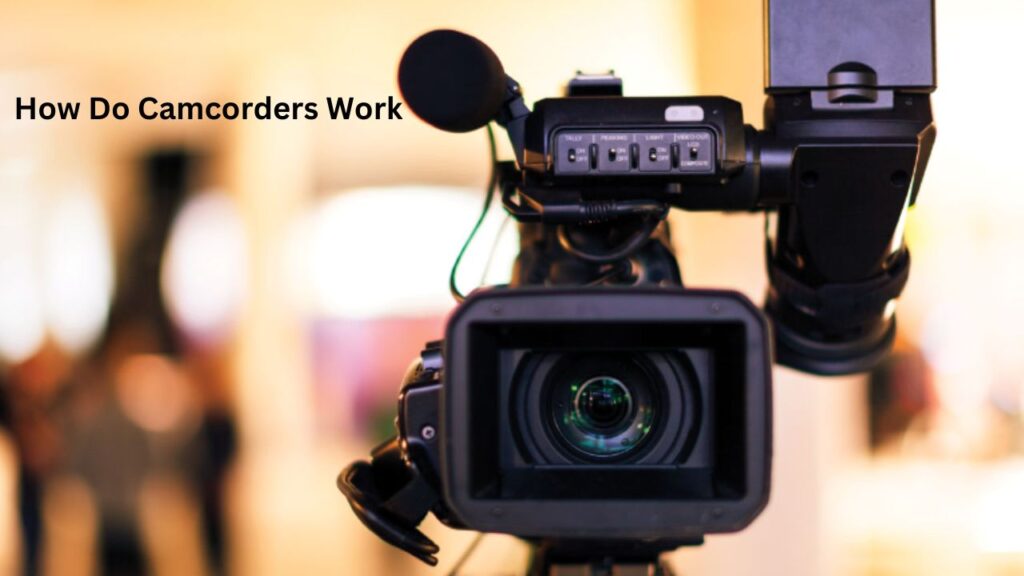Camcorders have revolutionized the way we capture and relive memories because they provide a seamless fusion of audio and visual recording capabilities.
Understanding how camcorders operate will improve the quality of your videos, whether you’re making family vacations, special events, or professional material.
The inner workings of camcorders and the technology that makes it possible for them to vividly capture life’s events will be examined in this article.
How Camcorders Work?
A typical analog camcorder contains two basic parts:
The Eye of the Beast: The Camera Section
Imagine a miniature movie studio packed into your camcorder. The star of the show is the CCD (Charge-Coupled Device), a tiny grid of light-sensitive pixels that acts like the camcorder’s eye. Light bounces off your subject, hits the CCD, and transforms into electrical signals.
As a result of clever circuits processing these signals, the raw visual data that serves as the basis for your video is created.
From Light to Tape: The Shrunken VCR Section
Consider the VCR part as the recording studio of the camcorder. It takes the raw visual data and converts it into a format that can be preserved on tape, much like your living room VCR.
It takes skillful compression techniques to fit all those vibrant colors and frenetic motions into a tolerable size.
At last, the video signal is faithfully captured by the magnetic tape, which is now spinning inside its tiny reels and ready to be rewound, fast-forwarded, and treasured for years to come.
Components of a Camcorder
The Lens: Our window to the world, the lens gathers light and focuses it onto the image sensor. It’s like the eye of the camcorder, determining the field of view, zoom capabilities, and overall image quality.
The Image Sensor: This is the heart of the camcorder, where the captured light is converted into an electrical signal. Modern camcorders use CMOS (Complementary Metal-Oxide-Semiconductor) or CCD (Charge-Coupled Device) sensors, which are essentially grids of millions of tiny light-sensitive pixels.
The entering light’s color and intensity are recorded by each pixel, creating the raw image data.
Signal Processing:
- Once the image sensor converts light into electrical signals, a signal processing unit enhances and processes these signals.
- Color filters help create a full-color image by dividing incoming light into red, green, and blue components.
The Processor: The brains of the operation, the processor takes the raw image data from the sensor and massages it into a viewable video format. Ultimately, it handles tasks like color correction, noise reduction, and compression to decide the video’s quality and file size.
Recording Media: Camcorders store recorded video and audio data on various recording media, such as tapes, DVDs, memory cards, or internal storage.
Audio System: Camcorders are equipped with microphones to capture audio, and some models may have additional inputs for external microphones. Audio signals are processed and synchronized with the video during recording.
While capturing stunning visuals is crucial, sound equally enhances the storytelling experience. Camcorders typically have built-in microphones, though some offer external microphone jacks for enhanced audio quality.
The captured audio is then synchronized with the video data for seamless playback.
Viewfinder and LCD Screen:
- The viewfinder and LCD screen allow users to compose shots and review footage.
- Modern camcorders often feature touchscreen LCDs for easy navigation and control.
Recording Format: Different recording formats that camcorders enable, including AVCHD, MP4, or MOV, control the compression and quality of the video that is captured. The video must be saved after it has been processed.
While newer camcorders rely on solid-state drives or flash memory, traditional camcorders employ magnetic tape cassettes. The video data is compressed by the recorder and written to a storage media for editing or later playing.
Zoom and Image Stabilization:
- Optical zoom preserves image quality by utilizing the lens to magnify the image.
- Vibrations or unsteady hands are compensated for by image stabilization technology, which results in smoother and steadier film.
Working Mechanism
Capturing Video:
- When the record button is pressed, the lens focuses light onto the image sensor.
- By converting light into electrical impulses, the image sensor creates a digital image of the scene.
- Processing Signals:
- The signal processing unit adds any chosen visual effects, balances the color, and improves the signals that were collected.
- The processed audio and video signals are then stored in the chosen recording format.
Storing Data:
- The recorded data is stored on the chosen recording medium, whether it’s a memory card, internal storage, or other media.
Playback and Display:
- During playback, the stored data is retrieved and displayed on the LCD screen or through the viewfinder.
- Audio playback is synchronized with the video for a cohesive viewing experience.
Conclusion:
Users may make better informed decisions on the ideal camcorder for their requirements if they are aware of the complex procedures that go into making these devices.
Every part, from the lens and image sensor to the signal processor and storage, is required to record and protect the memories we cherish.
More features and functionalities for camcorders should be possible as technology develops, opening up new possibilities for storytelling and artistic expression.
Whatever your degree of expertise as an amateur photographer or filmmaker, mastering the ins and outs of camcorder operation will enhance your video recording endeavors. Here is where you comment.
Also Read: Peoplelaptop

